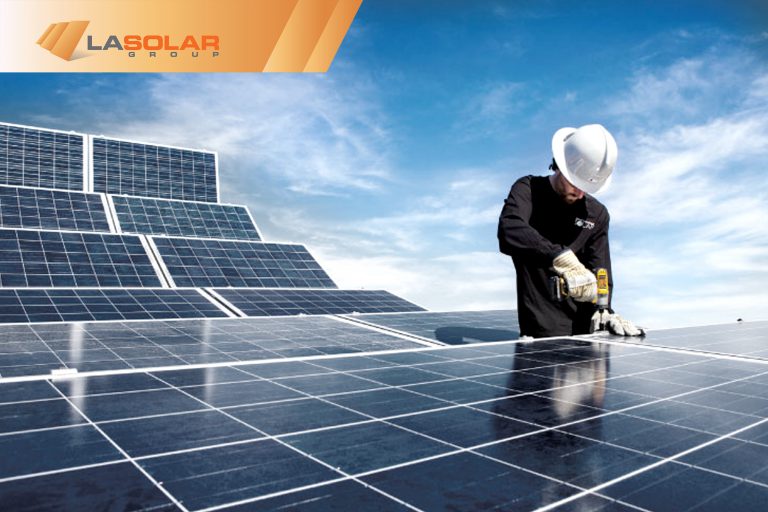Ground-mounted solar panels
Rooftop solar panels are the most sought-after option for homeowners to installing solar energy systems at their residences. Most homeowners are not aware that ground-mounted solar panels can be just as cost-effective and easy to install.
What are ground-mount solar panels?
Ground-mounted solar panels are solar panels that are positioned at ground level. They function in the same way as rooftop solar systems. These panels receive sunlight, which is then converted to electricity through solar cells. This is used to power a buildingor community when using solar farms.
These are the top three facts about ground mounted solar panels.
Ground-mounted solar systems are often the best choice.
Solar panels that are mounted on roofs have become the most popular option for homeowners. However, solar panels that are mounted on the ground are also an alternative.
Ground-mounted solar panels typically more expensive over rooftop panels because of the extra work and permits that could be required. Ground-mounted solar systems might reduce your costs in the long run if your home isn’t suitable for solar installations.
Rooftop solar arrays offer only a small range of performance because of the roof they’re placed on. Your solar array will not produce as much if it isn’t installed at the correct angle that faces south or has obstructions like skylights and chimneys. Ground-mounted solar panels, on the other hand, are able to be installed wherever optimal conditions exist.
You might also find that your roof isn’t large enough to accommodate a solar energy system that is able to meet your electricity consumption. Ground-mounted solar systems however can be adapted to meet your power needs without the restrictions of a rooftop system.
All ground-mounted solar panels systems are not created equal
There are two types of solar panels that are mounted on the ground. systems:
Ground-mounts are constructed of metal framing , which is placed in the ground. This keeps your panels at a set angle. The standard solar panels mounted on the ground can be adjusted manually to accommodate seasonal variations.
Pole-mounted solar systems can support multiple panels on a single pole and raise panels higher than conventional ground mounts. The majority of pole-mounted solar systems come with tracking systems that automatically tilt the panels to get the most sunlight.
With the help of tracking systems, the manufacturing of solar panels can be increased by as much as 25 percent. If you’re looking to add an automated tracking system to your array that is mounted on the ground, you have two alternatives. Single-axis tracking systems monitor your solar panels throughout the day by following the sun’s course across the sky. Dual-axis tracking systems are also able to account for seasonal changes in the sun’s position.
All homeowners can benefit from ground-mounted solar panels systems
Even if your house is suitable for rooftop solar energy the ground-mounted solar panels come with numerous advantages.
Ground-mounted solar panels are easy to set up because they can be placed on any surface. They don’t have to be installed on your roof.
Additionally, the bracings in conventional ground-mount systems can be removed without difficulty and are very light. They’ll be more secure when you select the pole-mount.
A ground-mount solar panel system can be more effective per solar panel than rooftop arrays. Ground-mounted solar panels don’t need to be attached to the roof, and they can be set at the most optimal angle for maximum energy production.
You can produce more electricity than a comparable-sized rooftop system and also save money over the long run.
Ground-mounted solar panels can be easily cleaned and maintained. It’s very practical to to sweep snow off of your panels if you reside in an area with lots of snow.
Ground-mount solar systems are available through [xfield-company] installers. The price of a traditional ground-mounted solar system is similar to the cost of a rooftop system. If you incorporate a tracking system you’ll need to pay an initial cost however this could be offset by higher power generation and makes tracking systems more reasonable for homeowners.
What is a suitable area for a ground-mounted solar system?
You want a space that’s perfect for you.
- In the southern part, flat or gently slopes (up up to five degrees).
- A floodplain that is more than 100 years old isn’t likely
- Shade from nearby trees not needed
- It is simple to find the existing electrical infrastructure without the need for trenching or cabling.
- Massive installation (above 100kW) aren’t evident from the homes around them.
- A suitable soil (not too soft so that concrete foundations are needed however not so difficult that pre-drilling is needed)
An investigation of geotechnical conditions is needed prior to a solar installation proceed. This will confirm that the correct solar mounting structure can be utilized, as well as the warranty.
Different Ground Mounted Solar Panel Racking Systems
Traditional - Steel pillars are the most affordable method to install the ground-mount systems. Steel pillars can be used to drive into only if the ground has been considered appropriate by the geotechnical assessment.
Concrete - Sometimes, a concrete footing is required in order to mount the panels. This will give you more stability and also wind resistance.
Ground Screw – Even though they’re more costly to install, ground screws are a solid solution. It is possible to drill the screws using specialized equipment.
Ballasted – It’s possible to not penetrate the ground entirely in the event that it is needed. Concrete blocks can be used to install solar panels. They can be placed on the ground and hold the solar system in the right place.
Single Axis Tracking: Tracking systems use motors that pivot panels through the day, ensuring that they are exactly at an distance from the sun. Single-axis trackers trace the path of the sun from East to West.
Dual Axis Tracking - Dual trackers are equipped with various motor choices that permit these panels to rotate in a more circular manner, thus maximizing the power output.
Ground-Mounted Solar: Drawbacks
Ground-mounted solar systems do have drawbacks, but it all depends on what your particular situation is.
The requirement for land is that it must be cultivated.
Ground-mounted systems have the obvious disadvantage of having to be installed on land. This makes them more appropriate for rural and suburban areas than urban ones. Ground-mounted solar systems capable of producing enough power to meet an American family’s daily requirements would require approximately 1,000 square feet of uninterrupted sunlight.
Potential Environmental Impact
The United States has more than 8 billion square metres of roofs which can be used to install solar panels. These panels are capable of double the nation’s electricity production capacity. There is no requirement to create more land available. Rooftop solar has a minimal environmental impact in terms of the land used.
A typical solar array that is mounted on the ground requires land to must be cleared and then graded before it can be covered with gravel. The sacrifice of land with a an environmental significance is expensive. It can lead to lost time for permitting and public approvals, aswell in the event of litigation.
Ground-mounted solar projects are able to be installed on land that is marginal, like brownfields or other land that is contaminated or disturbed to limit their environmental impact. You can also mount solar panels that are high enough to support agrivoltaics. This combines solar panels and agriculture. The panels can be used to help with the growth of crops or shade for livestock. The United States is introducing more renewable energy sitting tools to help with the environmentally-friendly development of ground-mounted solar plants.
A Zillow study has revealed that homes with solar panels are sold for 4.1 percentage less than similar homes without solar panels. However, a system that is mounted on the ground system may dissuade prospective buyers looking to use the property for another reason.
Extra Permitting
In certain urban areas, rooftop solar panels could be classified as “permitted expansion”. But, since this is a new application for a property, systems mounted on the ground could require approval from local zoning or environmental authorities. It is contingent on the size of the system and height, as and local regulations.
Extra Wiring
Ground-mounted systems require more wiring that connects to the house. To protect the wires from getting eaten by squirrels and other animals, it could be necessary to put them in a secluded area.
What is the cost of ground-mounted solar panels?
A solar system costs about $2.77 per Watt, on average. That means a 10 kilowatt system would cost $27,000.8 Ground-mounted systems are more expensive in upfront cost. We include extra mounting hardware and labor and permits.
A solar system is an investment that will last for a long time. It is therefore crucial to determine the return on investment (ROI) not only the initial cost. The ROI of a solar installation is determined by a variety of variables, including the price and efficiency of the system, expenses for financing, labor charges, incentives from the states and federal governments, and the price for electric power in your area. It takes between 7 and twelve years to allow the system’s cost to be fully payed off.
Its efficiency is the primary aspect that determines if an array mounted on the ground is more competitive in price than a rooftop solar array. It could be more efficient when it can generate more power with less panels. This would allow it to have a faster return on investment.
Is Ground-Mounted Solar cheaper than Roof-Mounted Systems?
Ground-mounted systems may be more costly than roof-mounted systems, even though it may seem like a contradiction. Even though it could seem that the burden of putting panels on roofs and having them put in difficult locations could be expensive, having the roof for building on could help lower costs.
Solar panels that are mounted on roofs require a foundation to set up the racking. It may be necessary to lay a foundation using cement or other materials. But, this is not just about mounting the solar mounting brackets for your panels and calling it a day.
Ground-mount panels are more costly than roof-mount, however it’s not much. You might need additional permits based on the size of your solar array and foundation. This can take time and costs.
Ground-mounts are able to be adjusted manually throughout the year so that they get the most benefit from the sun’s rayons. Although they might not provide the same flexibility as pole-mount systems however, they can be more easily adjusted than roof-mount systems. This increases electricity production and reduces the cost gap.
It’s important to note that even though the installation may cost more, the ground-mount panels will be more efficient. They don’t require being adjusted to the orientation or direction that your roofing has. This allows them to be placed to get the best sun exposure. This means you will receive more power and could reduce your costs throughout the lifetime of your solar panel.
Ground-mounted solar panels: What are the pros and cons?
It is important to be aware of the pros and cons of a ground-mounted system if you’re thinking about one over a roof system. Your needs and the parameters which you and your contractor will decide on will ultimately impact your choice.
Pros
Freestanding solar panels have the benefit of maximising the amount of sunlight that is absorbed. Even though your rooftop may not be perfectly oriented (e.g. it’s in the south and has a slope of 30-40 degrees) You can decide the best way to install your solar system on the ground to maximize the energy output. Systems that have been mounted to the ground are much more effective since they have greater air circulation beneath the panels. This allows them to remain cool. Systems mounted on the ground are simpler to access to perform maintenance. This could reduce the cost of labor.
Cons
Ground-mounted systems aren’t the best fit for everyone. Rooftop systems can be placed on top of your roof, and they can take up the space of your property. Ground-mounted systems could necessitate you to work with property. This can be a problem for homeowners who want to use the land for gardening, recreation or farming. In certain situations you might be able to combine farming and ground-mounted systems with the agrivoltatics. Ground-mounted solar panels are more vulnerable to damage by animals or people who try to modify the equipment. Ground mount solar systems are more expensive in the event that you don’t need extensive repairs to your roof in order to set up a solar panel on your roof (which is likely to be required to complete in the future).
[xfield-company] is the best place to start your solar journey.
You can request seven estimates from local installers through the [xfield-company] Marketplace. This will allow you to choose the system that best suits your needs and will be at the best price. Make sure to register your property today to talk to one of our Energy Advisors, who will be able to answer your questions throughout your entire registration process.




